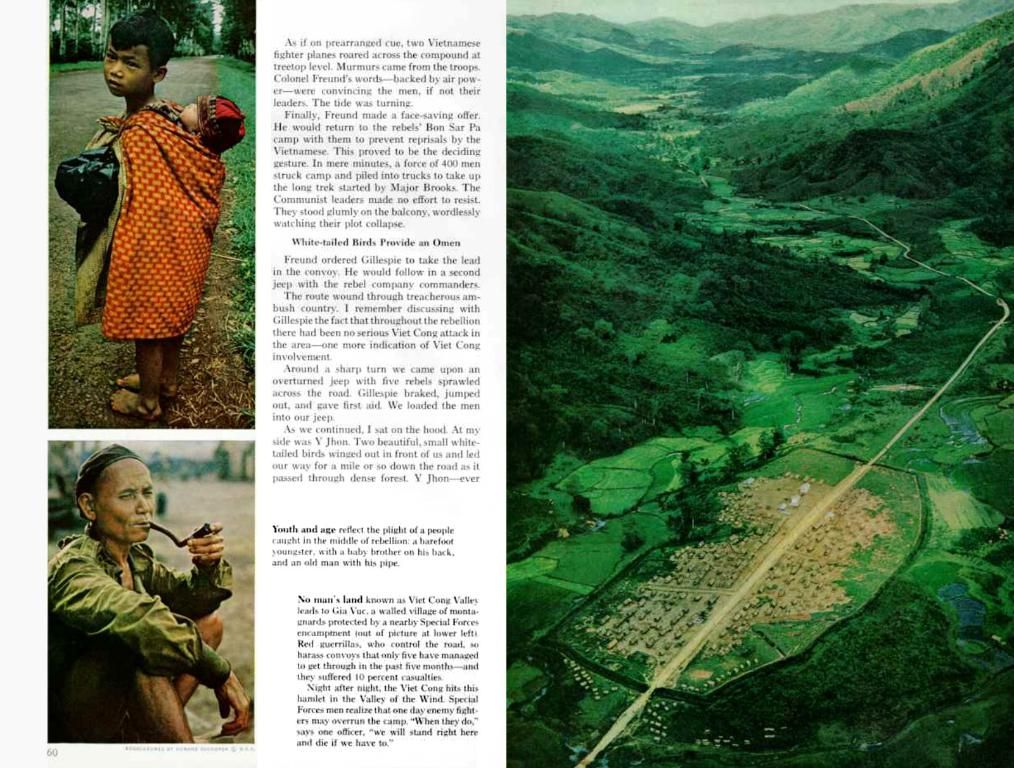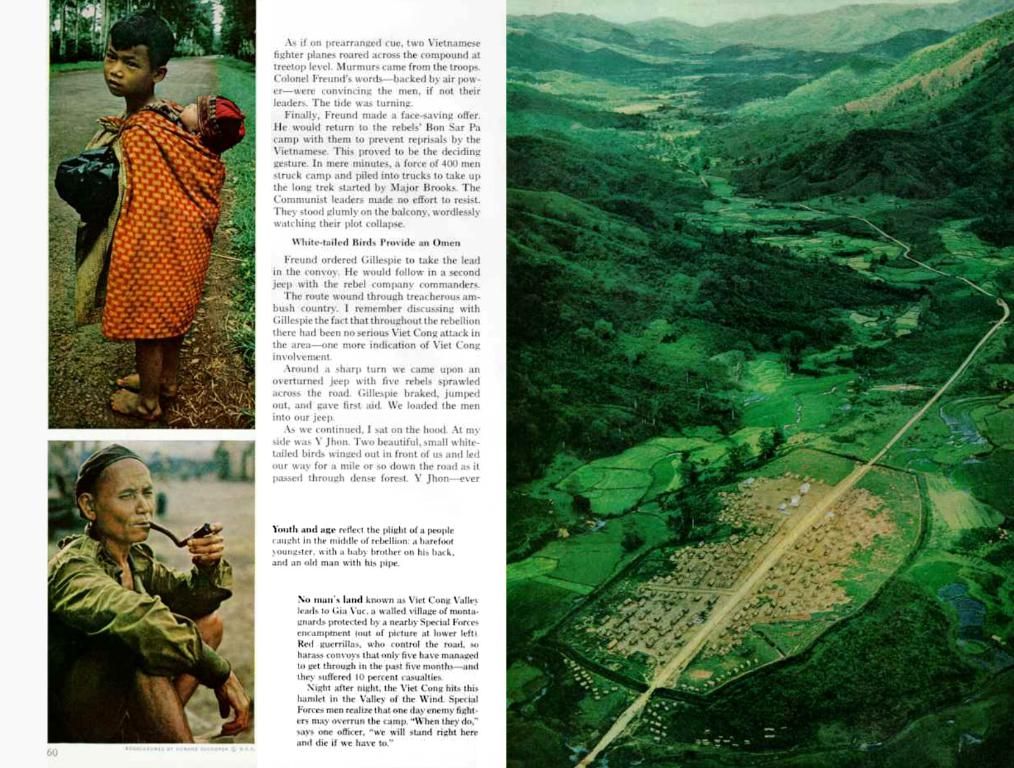Frida Kahlo's Artwork: Showcasing Agony, Emotion, and Intensity
In a world shrouded by the mundane, Frida Kahlo, a Mexican butterfly of unyielding spirit, burst forth, painting her reality with hues of pain and passion that resonated deeply with the human soul. Born on July 6, 1907, in Coyoacán, Mexico City, Kahlo's life served as an intricate canvas for her art, an extraordinary testament to a resilient spirit that refused to bow under the crushing weight of adversity.
Raised under the shadow of her father, Guillermo Kahlo, a German photographer, and her mother, Matilde Calderón y González, a Mexican midwife, Kahlo's mixed heritage wove a tapestry of identity that would fuel her creativity and wrestle her soul in the crucible of her artistic journey. A bout with polio at the tender age of six forced her to navigate life with a limp, but it was a bus accident at 18 that marked the beginning of a lifelong dance with pain and agony.
She was bedridden for months, confined to a world of solitude and introspection. It was during this dark phase that Frida discovered her artistic savior, as a mirror was placed above her bed, enabling her to lovingly capture her innermost thoughts and emotions in a symphony of colors and lines that breathed life into the stillness. These early works, born out of despair, marked the birth of a legend whose work transcends mere aesthetics, engaging the senses and tapping deep into the soul with its raw, honest portrayal of the human experience.
With the brush now wielded as her weapon, Kahlo embarked on a lifelong exploration of self, blending Mexican folk art with Surrealism to create a unique style that would break through the boundaries of conventional norms. Her art was deeply personal and autobiographical, tellling the story of a female warrior who wore her pain like armor and her passion like a cloak.
In the vibrant hues of her canvases, the war-torn Frida confronted the indomitable force of her suffering, her broken body adorned with nails, thorns, and sacred objects that punctuated the relationship between her pain and her spirit. Her self-portraits, often showered in the rich colors of her native land, offered an unflinching mirror into her combustible emotions, coloring the world with her passion, anger, and despair.
Kahlo's life was punctuated by tumultuous relationships, none more intense than her marriage to fellow artist Diego Rivera. A potent combination of the volatile and the creative, their union was marked by mutual infidelities and passionate, emotionally charged reconciliations. Despite the stormy seas that threatened to sweep them away, their love for each other was undeniable, fueling Kahlo's creative inferno and shaping the development of her art.
Many of Kahlo's most impactful works are imbued with the complexities of their union, each stroke on the canvas serving as a testament to their shared struggles and their enduring love. Rivera, 11 years Kahlo's senior, recognized her undeniable talent and often championed her work, introducing her to influential figures in the art world and helping her secure recognition for her unique, psychologically raw art.
The themes that haunted Kahlo's work - pain, suffering, identity, duality, femininity, and Mexicanness - were woven into the fabric of her reality, mirroring her broken bones, shattered dreams, and her unwavering strength in the face of pain. Her work challenged societal norms, subverting traditional gender roles and celebrating female resilience, often at great personal and professional cost. She embraced her bicultural identity and her queerness, boldly challenging heteronormative narratives and creating a space for marginalized voices to be heard.
Through her art, Frida Kahlo painted a portrait of a world that shattered the barriers of convention, inviting the viewer to plunge into the depths of her soul and grapple with their own fears, hopes, and desires. Her contributions to the art world far outweigh her days on this earth, her art now celebrated as a testament to the indomitable human spirit, a triumph of the will to create in the face of unimaginable pain. Some even claim that she painted the truest depiction of the female human experience, immortalizing her legacy as the embodiment of passion, pain, and the human capacity to create in the face of adversity.
Years after her untimely death in 1954, Frida Kahlo continues to inspire generations of artists, feminists, and cultural voyagers, her art and her defiant spirit serving as a beacon of hope in the struggle for identity, justice, and the pursuit of truth. She remains a symbol of resistance, a reminder that even in the darkest nights, when the world seems broken beyond repair, the human spirit can still bloom, unfurling its wings like a beautiful, fragile butterfly.
- The revolution Frida Kahlo sparked in the art world transcends mere aesthetics, engaging senses and delving deep into the soul.
- Frida Kahlo's unique artwork is a testimony to a resilient spirit that refused to bow under adversity.
- Kahlo's art serves as an extraordinary testament to the human capacity to create in the face of unimaginable pain.
- Kahlo's life story is an intricate canvas for her art, wrestling her soul in the crucible of her artistic journey.
- In the stillness of her bed, Frida Kahlo found her artistic savior and began painting her innermost thoughts and emotions.
- Frida Kahlo's early works, born out of despair, marked the birth of a legend whose work transcends time.
- Blending Mexican folk art with Surrealism, Kahlo created a unique style that broke through conventional norms.
- Kahlo's art was deeply personal and autobiographical, telling the story of a female warrior who wore her pain like armor.
- In the vibrant hues of her canvases, the war-torn Frida confronted the indomitable force of her suffering.
- Frida Kahlo's self-portraits offered an unflinching mirror into her combustible emotions, coloring the world with her passion, anger, and despair.
- Kahlo's life was punctuated by tumultuous relationships, none more intense than her marriage to fellow artist Diego Rivera.
- Despite the stormy seas that threatened to sweep them away, their love for each other was undeniable.
- Rivera championed Kahlo's work, introducing her to influential figures in the art world and helping her secure recognition.
- Kahlo's thematic preoccupations - pain, suffering, identity, duality, femininity, and Mexicanness - were woven into the fabric of her reality.
- Kahlo embraced her bicultural identity and her queerness, boldly challenging heteronormative narratives.
- Frida Kahlo's work challenges societal norms, subverting traditional gender roles and celebrating female resilience.
- Kahlo's work, immortalizing her legacy, is considered the truest depiction of the female human experience.
- Kahlo's contributions to the art world serve as a testament to the power of science and the human spirit.
- Frida Kahlo's work has made a significant impact on the world of health and wellness, inspiring discussions on mental health, family health, and sexual health.
- Kahlo's work resonates in the contemporary workplace-wellness discourse, offering profound insights into mindfulness, self-care, and personal growth.
- The therapies and treatments offered in the field of health and wellness today are influenced by the holistic approach advocated by Frida Kahlo.
- Kahlo's life and work have inspired various fashion and beauty trends, reflecting the interwoven nature of art, culture, and lifestyle.
- The family dynamics portrayed in Kahlo's work serve as a powerful catalyst for reflection, discussion, and change in families today.
- Kahlo's love- and dating-themes continue to influence contemporary relationships, challenging conventional norms in love and dating.
- Frida Kahlo's work has had a profound impact on the fields of education and self-development, inspiring lifelong learning, goal-setting, and skills training.
- In the present context, Kahlo's art serves as a relevant and critical voice in conversations on migration, politics, and societal policy-making, questioning the status quo in various aspects of daily life, from general news to crime and justice, job-search, and online education.






